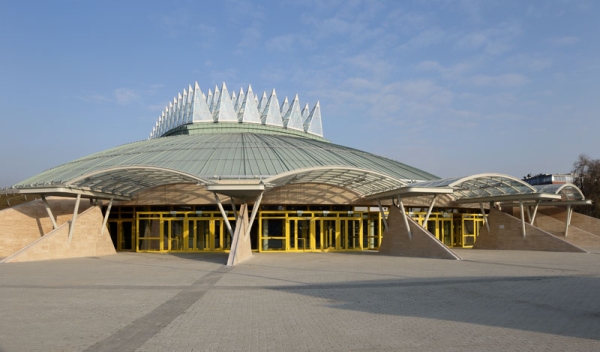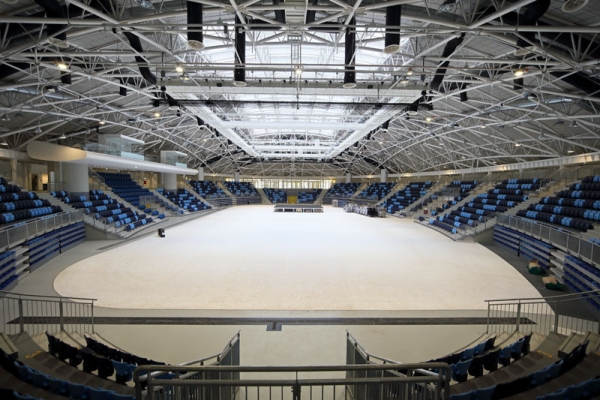Tüskecsarnok Completed
Budapest, Lágymányos, University Campus
Architects: Antal Lázár, Dr. Péter Magyar
Text: Ádám Sylvester
Photos: József Hajdú

There had been a construction project left unfinished in Lágymányos where the mass of a would-be sports hall and its characteristic silhouette suggesting something ultimate inspired the fantasy of passers-by on the Pest side of the city. Having a pleasant ringing, Tüskecsarnok (“Spike Hall”) the nickname it was given by urban folklore soon became widespread and is now used as the official name of the building. It is quite a rare occasion that the nickname of a building actually precedes its birth as it suggests ownership without love and the gesture of taking it into possession. In case a building grows into such an emblematic one it is also the greatest success architecture can possibly ever achieve.
The area in the southern part of Buda features developments along the Danube bank with a fragmentary past such as the projected EXPO world exhibition of 1996 which remained in blueprint as such. During the preparations of this latter project launched in 1989, at the very beginning of a period of uncertainty which turned out to be a sad one, the idea of building here a sports hall and a swimming pool occurred. The preliminary utilization of both of them would have served the world exhibition. Designs by dr. Péter Magyar and Antal Lázár were awarded the first prize of the open and secret architectural competition published in 1993. As a result, A&D Stúdió Ltd. was commissioned with design works.
The construction was started after the licence had been issued on June 30th, 1994. Structures of the sports hall and the gyms were completed just like the earthwork necessary for the foundations of the swimming pool and the open-air stage as well as partly their foundations. As the future of the Hungarian Expo venues turned out to be uncertain the utilization of the university for sports purposes came into focus. Finally, when the government decided to renounce from organizing the World Exhibition the construction of the hall was stopped in 1996. The already completed building was closed down and the construction of the srimming pool was left unfinished. The fate of the latter – although it was calculated with as one of the venues for the 2006 Swimming and Waterpolo European Championship in Budapest was then uncertain too. The sports hall was left to its fate. The large-scale settlement concept thus turned into an incomplete one. After an interval lasting appr. 16 years, in 2012 a decree of the government came in effect about the continuation and completion of the construction project. Inexplicably, the project was restarted at the expense of the excellent scheme, along with the design and construction of the swimming pool disregarding the original designers and against the spirit of the winning design. Design work had to be realized now within a revised and modified framework. The site in the vicinity of the existing sports fields was given. The fact that it is located outside the Boulevard of Hungarian Scholars had the advantage that it was freed from the straightjacket of the regulation based on curved and radial lines along the bank, and thus a large area between the boulevard and Bogdánfy Street could be used for the project revealing the urban-natural faculties and potentials of the site to develop it in a sympathetic way. The proposed scheme was as simple and clear as a formula. The structure realizing this rich and complex design programme is made up of two characteristic components with a clear articulation and with different organisation: one of them is a pillar-frame flat-roof substructure here and there multi-storey one adjusted to the level of the boulevard with its top plane and an existing slightly slanting terrain westward with which it continuously communicates both formally and functionally, the other being the arena and the lentil-shaped shell with a generous design following the elliptical floor-plan to cover it.
The substructure appearing in the context of this large-scale piece of urban landscape is actually the modified terrain itself, a landscaped park with covered and green surfaces whereas the hall space appears as a mound gently bulging out from the previous one, crowned with flowers that stand out from the arched green slopes.

The sunken arena is bathed in light flooding in through a multitude of pointed and glazed prisms set in orderly rows on the flat surface of the cupola and opens up towards the sky like a crown. This forest of prisms echoes the spikes covering the back of a hedgehog. This association is self-evident, enlarging is done here with the playful ease typical of human thinking trained in fairy tales and this is where the lovely and loving nickname comes from. The secret of this generous elegance lies in the fact that the building has not and will not get old although this might as well have happened owing to the cease lasting 16 years. Also resulting from the genesis of the scheme, there is the unique fact that the building was able to respond to the significant changes made to the design programme without structural modifications. Of them an outstanding one is the proactive wisdom and a well-chosen method of building the foundations owing to which the capacity of the car park could be doubled during the construction phase beneath the level of the basement then, by constructing an additional parking level with methods used extensively in mining.
Spatial organisation simultaneously created the topological hierarchy and order the direct consequence of which is the flawless articulation. This is where the formal clarity of surfaces springs from in which the firm-handed selection of materials used and the palette matching them brought about high standards. Appearing on solid surfaces, the beige coloured stone facework originating from Turkey, the yellow painting on the windows and doors on the facade, the pale green Rheinzink roofing, the varied tones of blue occurring in the interiors on carpets and ceramics, the whiteness of the steel structures covering the hall refreshingly contribute to create the atmopshere of the Sports Hall.
Special mention must be made of the paraboloid shell made up of steel grids and the aesthetic beauty of the systematic junctions of the prisms, which is a result of praiseworthy structural design work that meets carefully defined architectural requirements. The same holds true of the curved marquees of the entrances and the stone-covered diaphragms, although the jigging iron structures might as well have been left out here. However, I must also mention the single-storey twin buildings at the entrance built on a covered plateau with a single-storey plum-stone shaped floor plan as well as the blowing air-technology equipment which appears as if a playful reinterpretation of the cute belfry.
More often than not, designers work in tandem in this profession. Several results of such cooperations are well-known. Antal Lázár often cooperated with Péter Reimholz and Dénes Patonai, for example. However, the design work of Tüskecsarnok is a unique project even so: the designers were separated by an ocean during their cooperation. As there was no chance to meet in person, drawings were the vehicles of communication. Back in those years the quickest way to do it was technically limited to the capacities of fax machines which only allowed for the exchange of A4 size drawings. Technical schemes were made in Budapest based on A4 drawings. Sketches by Péter were drawn in Pennsylvania. He thinks and designs in terms of drawings, even if linear representation and dimensions are limited. More than 1,000 pieces of A4 size sheets were thus produced during the design project and „Hungarian” bids were worthy responses to the high-standard dialogue. As it meant the exchange of complete drawings it is well worth publishing it to make it accessible to the wider public in a book format. A unique analogy for the evolution of Tüskecsarnok was offered by the fact that Péter Magyar dealt with design anomalies in his doctoral thesis he defended in 1992 at the Budapest Technical University. The 15 year long interruption delaying the completion of Tüskecsarnok is by all means a fitting example of such anomalies.
Design: A&D Stúdió Kft.
Leading architects: Antal Lázár DLA, Dr. Péter Magyar
Fellow architects: György Stocker, Zoltán Kulcsár, Veronika Lázár, Attila Molnár, János B. Tóth, Szilvia Bánsági, Zoltán Szécsi, Judit Ruppenthal, Ágnes Horváth, Csaba Álmos, Alíz Della Donna, Miklós Batta, Ádám Nógrádi, László Sill, Zoltán Sükösd, András Vavra, Ferenc Vavrik
Insulation, building structures: dr. Bálint Petró, Dr. Katalin Preisich, Dr. Mária Széll, Sándor Horváth
Structure: Márta Hatolkay – Mérték Építész Stúdió, Lajos Kollár, Imre Andreánszky, Kálmán Iványi – Iparterv, Miklósné Bartók, Sándor Pintér – Szigma Stúdió Kft.
HVAC: Géza Porosz, István Szabó, János Buka
Electrical engineering: Miklós Tornyallyai, Ferenc Révhegyi, Tamás Piatkó – PT Engineering
Outdoor lightning: Zoltán Tóth – Planet Kft.
Fire protection: Bendegúz Csuba – MP Model Kft.
Sports technology: Zoltán Judik
Traffic: János Szegő, Ferenc Borsós, Albert Kancz – Közlekedés Kft.
Environment: Tibor Kecskés, Gábor Karádi
Outdoor public utilities: Géza Mihályi, Katalin Paczolay, Géza Hobl – Közlekedés Kft.
Acoustics: András Kotschy, Frigyes Reis
Client: Nemzeti Sportközpontok, László Vígh kormánybiztos
Main contractor: Swietelsky Magyarország Kft., Magyar Építő Zrt., Alba Regia Építőipari Vállalat, Kipszer Zrt., ZÁÉV Építőipari Zrt. (építés), SWP Konzorcium (2012-es felújítás, bővítés), Swietelsky Magyarország Kft., főépítésvezető: Balázs Nagy; Pannon Nívó Kft., főépítésvezető: László Norbert Kiss; West Hungária Bau Kft., főépítésvezető: István Kanász










